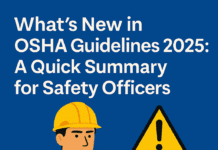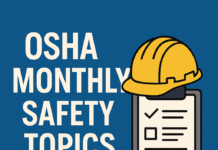
OSHA Safety Officer: 50 Duties Of A OSHA Safety Officer
In the realm of workplace safety, OSHA Safety Officers stand as guardians, dedicated to ensuring the well-being of employees and fostering secure working environments. An OSHA (Occupational Safety and Health Administration) Safety Officer is a certified professional tasked with implementing and overseeing safety measures according to OSHA regulations. Let’s explore the extensive responsibilities that define the role of an OSHA Safety Officer.
Understanding OSHA Certification
OSHA certification is a critical qualification for safety officers, providing comprehensive knowledge and skills related to occupational safety and health. OSHA Safety Officers play a pivotal role in translating this knowledge into effective workplace safety practices.
Responsibilities of an OSHA Safety Officer
Ensuring Compliance with OSHA Regulations
A fundamental duty of OSHA Safety Officers is to ensure strict compliance with OSHA regulations. This involves staying abreast of the latest standards, conducting regular audits, and implementing necessary changes to maintain a safe workplace.
Conducting Safety Training Programs
OSHA Safety Officers are responsible for designing and delivering OSHA-compliant training programs. These initiatives not only educate employees about safety protocols but also contribute to building a safety-conscious culture within the organization.
Emergency Response Planning
Effective emergency response planning is a cornerstone of OSHA Safety Officers’ responsibilities. They develop and implement emergency response plans, ensuring that employees are well-prepared to handle unforeseen situations through drills and exercises.
Safety Inspections and Audits
Regular safety inspections are crucial for identifying and mitigating potential hazards. OSHA Safety Officers conduct thorough inspections, ensuring compliance with OSHA standards, and actively prepare for and participate in OSHA audits.
Personal Protective Equipment (PPE) Management
OSHA Safety Officers are instrumental in managing personal protective equipment (PPE). They ensure the proper usage of PPE, monitor its availability, and oversee maintenance to guarantee the ongoing safety of employees.
Health and Safety Training
Designing and delivering OSHA-compliant training programs is a continuous responsibility. OSHA Safety Officers keep employees informed about new safety regulations and best practices, fostering a knowledgeable and proactive workforce.
Incident Investigation
In the unfortunate event of workplace incidents, OSHA Safety Officers conduct thorough investigations. Their findings guide the implementation of corrective actions to prevent similar incidents in the future, contributing to an overall safer workplace.
Documentation and Record-Keeping
Maintaining accurate safety records is essential for compliance and improvement. OSHA Safety Officers meticulously document safety measures, incidents, and improvements, providing a comprehensive record for future reference.
Communication with Management and Employees
Effective communication is key to successful safety management. OSHA Safety Officers regularly update management on safety matters and facilitate open communication with employees to address concerns and promote a shared commitment to safety.
Safety Culture Promotion
OSHA Safety Officers actively work towards fostering a safety-conscious culture within the organization. Encouraging employees to report safety concerns, participate in safety initiatives, and embracing a proactive mindset collectively contribute to a safer workplace.
Regulatory Compliance
Staying informed about changes in OSHA regulations is an ongoing responsibility. OSHA Safety Officers ensure their organization complies with all legal requirements, minimizing the risk of penalties and legal issues.
Hazard Identification and Control
Identifying and assessing workplace hazards is a continuous process for OSHA Safety Officers. They implement measures to control and eliminate risks, creating a safer and more secure work environment.
Collaboration with Other Departments
OSHA Safety Officers collaborate with various departments, including HR and facilities, to integrate safety measures seamlessly into different workflows. This interdisciplinary approach ensures a holistic safety strategy.
Continuous Improvement
OSHA Safety Officers actively seek feedback and implement continuous improvement strategies. This iterative process allows organizations to adapt to evolving safety challenges, stay ahead of potential risks, and maintain a proactive safety stance.
An OSHA (Occupational Safety and Health Administration) Safety Officer is responsible for implementing and enforcing safety regulations in the workplace. Here are 50 duties that an OSHA Safety Officer may perform:- Conduct safety inspections to identify hazards.
- Ensure compliance with OSHA regulations.
- Develop and implement safety programs.
- Provide OSHA compliance training to employees.
- Investigate workplace accidents and incidents.
- Create and maintain safety documentation and records.
- Develop and update safety policies and procedures.
- Monitor and enforce the use of personal protective equipment (PPE).
- Conduct hazard assessments and risk analyses.
- Implement and oversee lockout/tagout procedures.
- Review and interpret OSHA standards.
- Communicate OSHA regulations to employees.
- Conduct safety meetings and toolbox talks.
- Participate in safety committees.
- Develop emergency response plans and conduct drills.
- Investigate and report on near misses.
- Monitor and control exposure to hazardous substances.
- Conduct ergonomic assessments.
- Evaluate and control noise and vibration hazards.
- Inspect and ensure the proper use of safety equipment.
- Provide guidance on machine guarding and equipment safety.
- Implement fall protection measures.
- Monitor and control electrical safety.
- Assess and control chemical exposure in the workplace.
- Evaluate and manage confined space hazards.
- Conduct respirator fit testing and training.
- Ensure compliance with hazard communication standards.
- Oversee fire safety and evacuation procedures.
- Evaluate and control heat stress and cold stress factors.
- Review and approve contractors’ safety plans.
- Collaborate with first aid and medical response teams.
- Conduct safety inductions for new employees.
- Implement a process for reporting and investigating safety concerns.
- Develop and implement a hearing conservation program.
- Assess and control radiation exposure.
- Oversee the disposal of hazardous waste.
- Ensure compliance with machine safety standards.
- Review and update safety manuals and documentation.
- Conduct safety audits and assessments.
- Evaluate and control workplace violence risks.
- Monitor air quality and ventilation in the workplace.
- Assess and control exposure to biological hazards.
- Provide guidance on proper lifting and material handling.
- Investigate and report on occupational diseases.
- Review and interpret safety data sheets (SDS).
- Conduct safety inspections of vehicles and machinery.
- Develop and maintain a safety training matrix.
- Collaborate with human resources on return-to-work programs after injuries.
- Investigate complaints related to safety issues.
- Stay current with changes in OSHA regulations and industry best practices.
These duties emphasize the comprehensive role that an OSHA Safety Officer plays in promoting and maintaining workplace safety and health.In conclusion, the role of an OSHA Safety Officer is multifaceted, encompassing a diverse range of duties crucial for maintaining a safe and secure workplace. Their expertise and commitment contribute significantly to the well-being of employees and the overall success of an organization.
How to Check OSHA Accreditation
How to Become an OSHA Approved Trainer
How to Register for OSHA Training Certification Program
OSHA Safety Manager: OSHA Certified Safety Manager Salary
OSHA Safety Engineer: OSHA Certified Safety Engineer Salary
Frequently Asked Questions (FAQs)
- What is OSHA certification, and why is it important for safety officers?
OSHA certification is a vital qualification providing knowledge and skills for effective workplace safety management, ensuring safety officers can implement OSHA regulations.
- How often should safety inspections be conducted by an OSHA Safety Officer?
Regular safety inspections should be conducted frequently, with the frequency depending on the nature of the workplace and potential hazards.
- What role does an OSHA Safety Officer play in emergency response planning?
An OSHA Safety Officer is instrumental in developing and implementing emergency response plans, ensuring employees are well-prepared for unforeseen situations through drills and exercises.
- How does an OSHA Safety Officer promote a safety-conscious culture?
OSHA Safety Officers actively work towards fostering a safety-conscious culture by encouraging open communication, reporting of safety concerns, and regular training programs.
- Why is continuous improvement important in the role of an OSHA Safety Officer?
Continuous improvement is crucial for staying ahead of evolving safety challenges, adapting to new regulations, and ensuring that the organization’s safety measures remain effective.
























